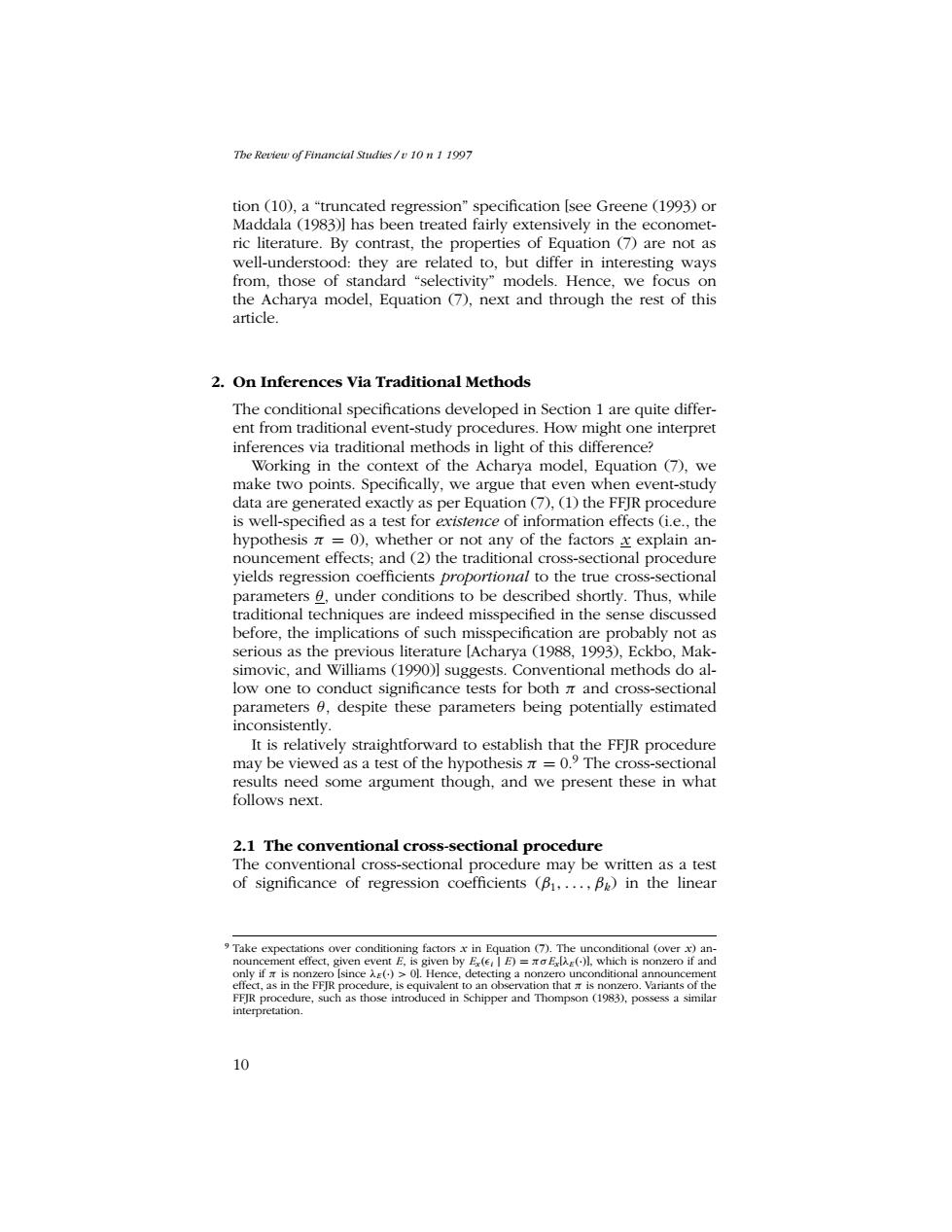正在加载图片...

The Review of Financial Studies /v 10n 1 1997 tion (10),a"truncated regression"specification [see Greene (1993)or Maddala (1983)]has been treated fairly extensively in the economet- ric literature.By contrast,the properties of Equation (7)are not as well-understood:they are related to,but differ in interesting ways from,those of standard "selectivity"models.Hence,we focus on the Acharya model,Equation (7),next and through the rest of this article. 2.On Inferences Via Traditional Methods The conditional specifications developed in Section 1 are quite differ- ent from traditional event-study procedures.How might one interpret inferences via traditional methods in light of this difference? Working in the context of the Acharya model,Equation (7),we make two points.Specifically,we argue that even when event-study data are generated exactly as per Equation(7),(1)the FFJR procedure is well-specified as a test for existence of information effects (i.e.,the hypothesis =0),whether or not any of the factors x explain an- nouncement effects;and (2)the traditional cross-sectional procedure yields regression coefficients proportional to the true cross-sectional parameters a,under conditions to be described shortly.Thus,while traditional techniques are indeed misspecified in the sense discussed before,the implications of such misspecification are probably not as serious as the previous literature [Acharya (1988,1993),Eckbo,Mak- simovic,and Williams(1990)]suggests.Conventional methods do al- low one to conduct significance tests for both a and cross-sectional parameters 6,despite these parameters being potentially estimated inconsistently. It is relatively straightforward to establish that the FFIR procedure may be viewed as a test of the hypothesis m=0.9 The cross-sectional results need some argument though,and we present these in what follows next. 2.1 The conventional cross-sectional procedure The conventional cross-sectional procedure may be written as a test of significance of regression coefficients (B1,...,B)in the linear 9 Take expectations over conditioning factors x in Equation (7).The unconditional (over x)an- nouncement effect,given event E,is given by Er(E)=xaE()l,which is nonzero if and only if is nonzero [since ()Ol.Hence,detecting a nonzero unconditional announcement effect,as in the FFJR procedure,is equivalent to an observation that is nonzero.Variants of the FFJR procedure,such as those introduced in Schipper and Thompson (1983),possess a similar interpretation. 10The Review of Financial Studies / v 10 n 1 1997 tion (10), a “truncated regression” specification [see Greene (1993) or Maddala (1983)] has been treated fairly extensively in the econometric literature. By contrast, the properties of Equation (7) are not as well-understood: they are related to, but differ in interesting ways from, those of standard “selectivity” models. Hence, we focus on the Acharya model, Equation (7), next and through the rest of this article. 2. On Inferences Via Traditional Methods The conditional specifications developed in Section 1 are quite different from traditional event-study procedures. How might one interpret inferences via traditional methods in light of this difference? Working in the context of the Acharya model, Equation (7), we make two points. Specifically, we argue that even when event-study data are generated exactly as per Equation (7), (1) the FFJR procedure is well-specified as a test for existence of information effects (i.e., the hypothesis π = 0), whether or not any of the factors x explain announcement effects; and (2) the traditional cross-sectional procedure yields regression coefficients proportional to the true cross-sectional parameters θ, under conditions to be described shortly. Thus, while traditional techniques are indeed misspecified in the sense discussed before, the implications of such misspecification are probably not as serious as the previous literature [Acharya (1988, 1993), Eckbo, Maksimovic, and Williams (1990)] suggests. Conventional methods do allow one to conduct significance tests for both π and cross-sectional parameters θ, despite these parameters being potentially estimated inconsistently. It is relatively straightforward to establish that the FFJR procedure may be viewed as a test of the hypothesis π = 0.9 The cross-sectional results need some argument though, and we present these in what follows next. 2.1 The conventional cross-sectional procedure The conventional cross-sectional procedure may be written as a test of significance of regression coefficients (β1,...,βk ) in the linear 9 Take expectations over conditioning factors x in Equation (7). The unconditional (over x) announcement effect, given event E, is given by Ex (²i | E) = πσEx [λE (·)], which is nonzero if and only if π is nonzero [since λE (·) > 0]. Hence, detecting a nonzero unconditional announcement effect, as in the FFJR procedure, is equivalent to an observation that π is nonzero. Variants of the FFJR procedure, such as those introduced in Schipper and Thompson (1983), possess a similar interpretation. 10